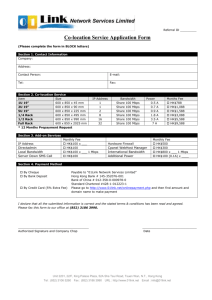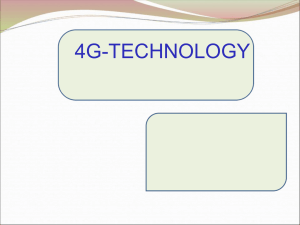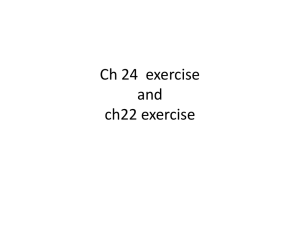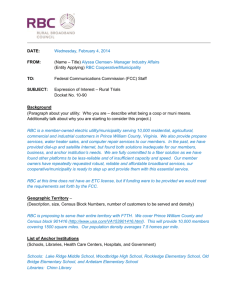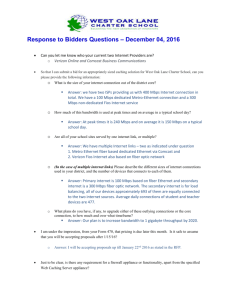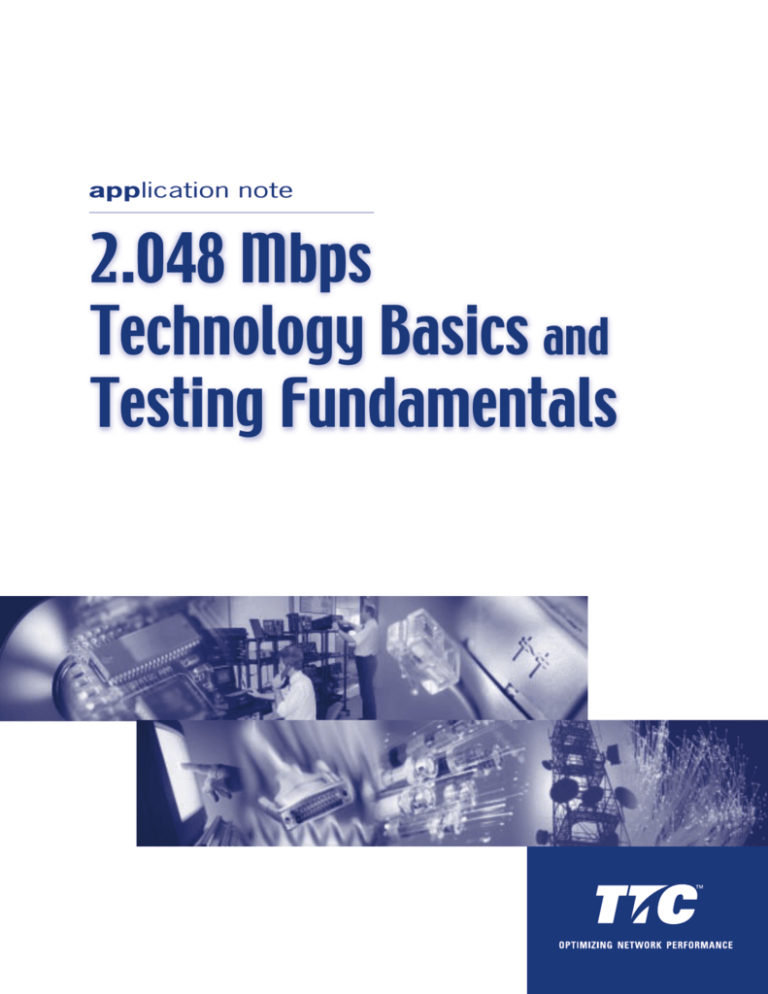
application note
2.048 Mbps
Technology Basics and
Testing Fundamentals
1
2.048 Mbps
Technology Basics and
Testing Fundamentals
T
he demand for high-quality 2.048 Mbps circuits requires thorough installation
testing and consistent maintenance and circuit analysis. To provide clean, error-free
transmissions, the 2.048 Mbps installation and maintenance personnel who test the
performance of these circuits demand reliable equipment for their testing needs.
TTC supplies a range of test sets that are ideal for 2.048 Mbps installation, acceptance testing,
routine maintenance, and fault isolation, all of which are integral to providing a quality
2.048 Mbps service.
This Application Note first describes 2.048 Mbps fundamentals and the impairments
that can degrade 2.048 Mbps services. It then provides examples of applications for
• In-service monitoring
• Out-of-service testing
Each application section includes guidelines on how to accurately interpret the test
results for rapid trouble shooting and fault isolation.
Those familiar with 2.048 Mbps basics may wish to turn immediately to the testing
applications beginning on page 9.
2
2.048 Mbps Basics
A
2.048 Mbps circuit provides
high speed, digital transmission
for voice, data, and video
signals at 2.048 Mbps.
2.048 Mbps transmission systems are
based on the ITU-T specifications G.703,
G.732 and G.704, and are predominant in
Europe, Australia, Africa, South America,
and regions of Asia. Due to an increase in
demand for global communications in
recent years, 2.048 Mbps installations in
North America have risen sharply, and exist
alongside the standard T-Carrier systems.
The 2.048 Mbps standards are
now firmly established for transmission
systems and are used by telecommunications
network suppliers, international carriers
and end users. The primary use of the
2.048 Mbps is in conjunction with
multiplexers for the transmission of
multiple low speed voice and data signals
over one communication path rather then
over multiple paths. Figure 1 shows a
typical system.
DTE 1
256
kbps
DTE 2
128
kbps
DTE 3
The 2.048 Mbps
Line Code
The most common line code used to
transmit the 2.048 Mbps signal is known as
HDB3 (High Density Bipolar 3) which is a
bipolar code with a specific zero suppression
scheme where no more then three consecutive zeros are allowed to occur. The HDB3
line code is recommended for 2.048 Mbps
signals by ITU-T Recommendations G.703,
and it is defined in Annex A to Recommendations G.703.
In some instances straightforward
bipolar AMI (Alternate Mark Inversion)
coding with no zero suppression is
also encountered.
In the following paragraphs, we will
first review the AMI coding format, which
represents the simplest version of bipolar
line code. We will then move on to
explaining the 2.048 Mbps HDB3 line code,
which essentially is a variation of AMI where
a high density of pulses is ensured by
applying a zero suppression algorithm.
NTE
MUX
AMI or Bipolar Line Code
In the AMI coding format, a binary
one (mark) is represented by a square pulse
with a 50% duty cycle and a binary zero
(space) is represented by the lack of pulse,
i.e., 0 Volts. Since successive pulses (i.e.,
marks) alternate in polarity the line code is
termed AMI (Alternate Mark Inversion).
HDB3 Line Code
Despite its numerous advantages,
AMI coding has one very significant
shortcoming. Since signal transition are the
only way for 2.048 Mbps equipment to
recover the timing information, long strings
of zeros with no pulse transition in the data
stream may cause the equipment to lose
timing. Hence AMI coding puts strict
limitations on the zero content of the data
transmission in the 2.048 Mbps system.
One solution to this problem is to
use a coding scheme that suppresses long
string of zeros by replacing them with a
specific sequence of pulses, which can be
recognised and decoded as zeros by
2.048 Mbps equipment. HDB3 is one such
coding scheme upon which the 2.048 Mbps
industry standardised.
NTE
2 Mbps
Network
MUX
64
kbps
256
kbps
DTE 1
128
kbps
DTE 2
64
kbps
DTE 3
Figure 1:
A typical 2.048 Mbps transmission system
3
How HDB3 Works
The HDB3 signal is a bipolar signal,
where sets of 4 consecutive zeros are
replaced by a specific sequence of pulses and
the last pulse is coded as a violation. This
ensures that the 2.048 Mbps signal has a high
density of pulses and no more then
3 consecutive zeros. Table 1 shows the rules
for zero substitution using the HDB3 coding
scheme.
An example of how these rules
are applied to an AMI signal is shown in
Figure 2.
It is important to note that:
Number of Bipolar Pulses (Ones)
Since Last Substitution
Polarity of
Preceding Pulse
Odd
Even
-
000-
+00+
+
000+
-00-
1. The 4th zero is always coded as a violation
pulse.
2. The 1st zero may be coded as a
“balancing” pulse to ensure that
successive HDB3 violation pulses are
of opposite polarity, so that the net DC
component of the signal remains zero.
Table 1:
HDB3 substitution rules
Hence the HDP3 code eliminates
all the limitations on the zero content of
the signal transmitted in the 2.048 Mbps
system, while preserving all the advantages
of AMI coding.
Binary
1
1
1 0
0
0
0
1
1
0 0
0
0
1
1 0
0
1
0 0
0
0
0 0
0
0
AMI
V
V
HDB 3
B
V
B
V
V = Pulse violating the AMI sequence
B = Additional pulse ensuring that the consecutive V pulses are of opposite polarity
Figure 2:
Example of a HDB3 signal
4
The 2.048 Mbps
Framing Format
One 2.048 Mbps Frame
The 2.048 Mbps signal typically
consists of multiplexed data and/or voice
which requires a framing structure for
receiving equipment to properly associate the
appropriate bits in the incoming signal with
their corresponding channels. Figure 3
shows the framing for the 2.048 Mbps signal
as defined in ITU-T Recommendation G.704.
As can be seen in Figure 3, the
2.048 Mbps frame is broken up into 32
timeslots numbered 0-31. Each timeslot
contains 8 bits in a frame, and since there
are 8000 frames per second, each time
slot corresponds to a bandwidth of
8 x 8000 = 64 kbps.
Time slot 0 is allocated entirely to the
frame alignment signal (FAS) pattern, a
remote alarm (FAS Distant Alarm) indication
bit, and other spare bits for international and
national use. The FAS pattern (0011011)
takes up 7 bits (bits 2-8) in timeslot 0 of
every other frame. In those frames not
containing the FAS pattern, bit 3 is reserved
for remote alarm indication (FAS Distant
Alarm) which indicates loss of frame
alignment when it is set to 1. The remaining
bits in timeslot 0 are allocated as shown in
Figure 4.
If the 2.048 Mbps signal carries no
voice channels, there is no need to allocate
additional bandwidth to accommodate
signalling. Hence, time slot 1-31 are available to transmit data with an aggregate
bandwidth of 2.048 Mbps - 64 kbps (TSO)
= 1.984 Mbps.
Frame 0
TS 0
TS-16
TS-31
Time Slot
0
Time Slot
1
Time Slot
2
Time Slot
31
125 µs
Bits
1
2
3
4
5
6
7
8
Frame containing
frame alignment Si
signal (FAS)
0
0
1
1
0
1
1
Frame not
containing frame
alignment signal
1
A
Si
Sn Sn
Sn Sn
Sn
Frame Alignment Signal (FAS) pattern - 0 0 1 1 0 1 1
Si = Reserved for international use (Bit 1)
Sn = Reserved for notational use
A = Remote (FAS Distant) Alarm - set to 1 to indicate alarm condition
Figure 3:
The 2.048 Mbps framing format
Frame 1
Frame 2
TS 0
Frame 3
TS-16
Bits
Frame 15
TS-31
TS 0
TS-16
Bits
1
2
3
4
5
6
7
8
0
0
0
0
X
Y
X
X
1
A
2
3
4
5
B
C
D
A
Channel 1
(TS-1)
TS-31
Bits
6
7
8
1
B
C
D
A
Channel 16
(TS-17)
2
3
4
5
B
C
D
A
Channel 15
(TS-15)
6
7
8
B
C
D
Channel 30
(TS-31)
Multiframe Alignment Signal (MFAS) pattern - 0 0 0 0
X = Spare parts (set to 1 if not used)
Y = Remote Alarm (set to 1 to indicate loss of multiframe alignment)
A B C D = Signaling bits
NOTE: Even numbered frames contain the FAS pattern in time slot 0
Figure 4:
The 2.048 Mbps TS-16 multiframe format
5
If there are voice channels on the
2.048 Mbps signal, it is necessary to take
up additional bandwidth to transmit the
signalling information. ITU-T Recommendation G.704 allocates time slot 16 for the
transmission of the channel-associated
signalling information. This is explained in
the next section.
The 2.048 Mbps
TS-16 Multiframe
Format
The 2.048 Mbps can carry up to
thirty 64 kbps voice channels in time slot
1-15 and 17-31.
Voice channels are numbered
1-30; voice channels 16-30
are carried in time slot 17-31.
Sub-multiframe
(SMF)
I
Multiframe
II
However, the 8 bits in time slot 16 are
not sufficient for all 30 channels to signal in
one frame. Therefore, a multiframe structure
is required where channels can take turns
using time slot 16.
Since two channels can send their
ABCD signalling bits in each frame, a total
of 15 frames are required to cycle through
all of the 30 voice channels. One additional
frame is required to transmit the multiframe
alignment signal (MFAS) pattern, which
allows receiving equipment to align the
appropriate ABCD signalling bits with their
corresponding voice channels. This results in
the TS-16 multiframe structure where each
multiframe contains a total of 16 2.048 Mbps,
numbered 0-15. Figure 4 on the previous
page shows the TS-16 multiframe format for
the 2.048 Mbps signal as defined by the
ITU-T Recommendation G.704.
As can be seen in Figure 4, time
slot 16 of frame 0 contains the 4-bit long
multiframe alignment signal (MFAS) pattern
(0000) in bits 1-4. The “Y” bit is reserved for
the remote alarm (MFAS Distant Alarm) which
indicates loss of multiframe alignment when it
is set to 1.
Frame
Number
Bits 1 to 8 (TS 0) of the Frame
1
2
3
4
5
6
7
8
0
1
2
3
C1
0
C2
0
6
7
C3
1
C4
0
0
A
0
A
0
A
0
A
1
Sn
4
5
0
1
0
1
0
1
0
1
0
Sn
1
Sn
1
Sn
1
Sn
0
Sn
1
Sn
1
Sn
0
Sn
0
Sn
0
Sn
0
Sn
1
Sn
0
Sn
1
Sn
1
Sn
1
Sn
0
Sn
1
Sn
1
Sn
8
9
10
11
12
13
14
15
C1
1
C2
1
C3
Si
C4
Si
0
1
0
1
0
1
0
1
0
A
0
A
0
A
0
A
1
Sn
0
1
Sn
0
0
Sn
0
1
Sn
0
1
Sn
0
Sn
1
Sn
1
Sn
0
Sn
1
Sn
1
Sn
1
Sn
Sn
1
Sn
Sn
0
Sn
Sn
1
Sn
Sn
1
Sn
C1, C2, C2, and C4 = Cyclic Redundancy Check Bits
CRC Multiframe Alignment Signal 0 0 1 0 1 1
Sn = Reserved for notational use
A = Remote (FAS Distant) Alarm - set to 1 to indicate alarm condition
6
Time slot 16 of frames 1-15 contains
the ABCD signalling bits of the voice channels.
Time slot 16 of the nth frame carries the
signalling bits of the nth and (n+15)th voice
channels. For example, frame 1 carries the
signalling bits of voice channels 1 and 16,
frame 2 carries the signalling bits of channels
2 and 17 etc.
It is also important to note that the
frame alignment signal (FAS) is transmitted in
time slot 0 of the even numbered frames.
We have thus explained how frame
alignment and channel associated signalling
are achieved in 2.048 Mbps transmission.
(Alternatively, time slot 16 may also be used
for common channel signalling applications
such as primary rate ISDN). It must be noted,
however, that the 2.048 Mbps framing and
TS-16 multiframing structures discussed
so far do not provide any built in error
detection capabilities, which could be used
to determine the error performance of the
2.048 Mbps system on an in-service basis.
This capability is provided by the CRC (Cyclic
Redundancy Check) multiframe structure as
explained in the next section.
Figure 5:
The 2.048 Mbps
CRC multiframe format
The 2.048 Mbps CRC
Multiframe Format
This section describes the specifics
of the 2.048 Mbps CRC Multiframe format.
To find out how CRCs provide the enhanced
error performance monitoring capabilities
mentioned above, refer to the “CRC Error
Analysis” section (page 9) under Application
#1, In-Service Analysis of Live Traffic.
The 2.048 Mbps CRC Multiframe
structure as defined by ITU-T Recommen-
dation G.704 is shown in Figure 5 on the
previous page.
The CRC Multiframe consists of
16 frames (numbered 0-15) which are
divided into two sub-multiframes (SMF-1
and SMF-11) of 8 frames each. The 4-bit
long CRC word associated with each submultiframe, SMF(N) is inserted into the
next sub-multiframe, SMF(N+1). The CRC
bits take up the 1st bit of time slot 0s
containing the 7-bit FAS (Frame Alignment
Signal) pattern. The CRC Multiframe
alignment signal uses the 1st bit of time
slot 0s not containing the FAS pattern.
(See Figure 5).
Combining the TS-16 and
CRC Multiframe Structures
A 2.048 Mbps signal may come
in a number of different formats, depending
on which of the above frame and multiframe
structures are implemented in the 2.048
Mbps system. Table 2 gives a comparison of
the possible variations of a 2.048 Mbps signal.
Framing Format
Total Bandwidth
Available for Data/Voice
Notes/Limitations
No Framing
2.048 Mbps (32 time slots)
Cannot use the publicly switched network.
No Multiframing
1.984 Mbps (31 time slots)
No voice transmission with TS-16 signalling possible.
TS-16 Multiframing
No CRC Multiframing
1.920 Mbps (30 time slots)
No error performance monitoring via CRCs.
CRC Multiframing
No TS-16 Multiframing
1.984 Mbps (31 time slots)
No voice transmission with TS-16 signalling possible.
TS-16 Multiframing
and CRC Multiframe*
1.920 Mbps (30 time slots)
Voice transmission with TS-16 signalling and error monitoring
possible.
*Note:
The two multiframe structures are not related, and need not be aligned with each other in any way.
Table 2:
Various 2.048 Mbps frame and multiframe formats
7
Causes of 2.048 Mbps Impairments
T
here are four main causes of
2.048 Mbps impairments:
1. Faulty Equipment: Any piece of
2.048 Mbps equipment can cause
errors when the components fail or
operate outside of specifications. Errors,
which can signal faulty equipment, include
code errors, bit errors, FAS (frame)
errors, excessive jitter, and slips. For
instance, code errors can occur due to
faulty clock recovery circuitry in span
repeaters. These errors occur as the
equipment becomes older and begins to
drift out of specifications.
2. Improper Connections: Transmission
errors are created by improper connections or configurations. For example,
intermittent errors can occur when
component or cable connections are
loose, and timing errors can occur when
improper or conflicting timing sources are
connected together. Dribbling errors are
often caused by loose or unconnected
shield ground cables and by bridge taps.
Further, upon installation, the circuit may
not work at all due to mislabelled pin-outs
on terminating cable blocks and to flipflopped wires: transmit-to-transmit as
opposed to transmit-to-receive. These
errors are typically discovered upon
circuit installation and possibly during
circuit acceptance when tests are
performed end-to end.
3. Environmental: Electrical storms, power
lines, electrical noise, interference, and
crosstalk between transmission links can
cause logic errors, FAS (frame) errors,
CRC errors in addition to code errors.
Typically, these conditions cause
intermittent, bursty errors, which are
some of the most difficult to locate.
4. Data Specific: Data characteristics, such
as repetitive patterns, can force equipment
to create pattern-dependant jitter and
code errors. These errors may not exist
when testing the transmission path with
standard pseudorandom patterns.
Analyzing 2.048 Mbps Impairments
Techniques and
Measurements
T
o analyse a 2.048 Mbps circuit’s
performance and to isolate the
causes of degraded services, the
test set must perform many
measurements in different scenarios.
There are four typical scenarios where
2.048 Mbps testing is required:
1. Installation: When installing a
2.048 Mbps circuit, out-of-service testing
is very useful in verifying equipment
operations and end-to-end transmission
quality. One starts by testing the equipment
(such as NTE’s, channel banks, multiplexers), and then verifying cable connections, timing source selections, and
frequency outputs.
Application #2 covers this test
scenario.
8
2. Acceptance Testing: In addition to the
test performed during installation, two
other tests—stress tests and timed tests—
should be performed to ensure that the
2.048 Mbps circuit is operating properly
with respect to the relevant 2.048 Mbps
circuit specifications and tariff. The
equipment may be stressed by verifying
the transmission frequency around
2.048 Mbps equipment. The same
procedure may be performed end-to-end
to stress the entire 2.048 Mbps circuit.
Timed tests with printouts should be
performed over a 24- or 48-hour period
using standard pseudorandom patterns,
which simulate live data.
Application #2 is useful for this
scenario.
3. Routine Preventive Measure: Routine
maintenance test are strongly recommended once live data is transmitted
across the 2.048 Mbps circuit. Routine
maintenance can alert technicians to
degrading service before it disrupts
normal operations. In most instances,
this involves monitoring the live data for
alarms, code errors, FAS (frame) errors,
CRC errors, and signal frequency
measurements which provide information
about the performance of the 2.048 Mbps
circuit. These tests should be performed
with printouts over a 24- or 48-hour
period to detect time specific or
intermittent errors.
Application #1 covers this scenario.
4. Fault Isolation: Fault isolation is
required once service is disrupted due to
excessive error rates. This can be
performed using both in-service and outof-service tests. In-service monitoring
provides general information and can be
used before out-of-service analysis to
localise problems and minimise circuit
downtime. By monitoring the circuit at
various points, technicians are able to
analyse the results and determine where
problems are originating. By performing
standard out-of-service tests, such as
loopback and end-to-end tests, technicians are able to stress the equipment,
find sources of errors, and verify proper
operation once the trouble is repaired.
Application #1 and Application #2
are relevant for fault isolation.
Application #1:
In-Service Analysis of Live Traffic
T
•
•
•
he following sections explain how
to evaluate the performance of a
2.048 Mbps system using
customer data. It is useful:
When performing periodic maintenance
and when looking for transmission
degradation before it effects service.
When analysing the span for intermittent
errors, which are caused by faulty
equipment or environmental influences.
For analysis of 2.048 Mbps circuits which
cannot be taken out-of-service.
NTE
MUX
Local
Exchange
•
Before out-of-service analysis, to
localise the problem and minimise
circuit downtime.
To achieve all these benefits, the
TTC test set may be configured to monitor
the 2.048 Mbps circuit from practically
any 2.048 Mbps access point. Figure 6
shows a typical circuit and possible
monitoring locations.
DCS
DCS
Digital
Network
Analysis of Alarm
and Error Indications
(In-Service Testing)
Testing and troubleshooting of a
2.048 Mbps signal requires regular
monitoring for alarms and errors. The
monitoring for alarms and errors allows the
user to detect and sectionalize transmission
lines or equipment problems in a 2 Mbps
signal. Errors can also be intentionally
injected to see the response of the system.
Table 3 highlights some of the
important alarm and error indications along
with possible reasons and solutions.
Local
Exchange
NTE
MUX
Figure 6:
Possible 2.048 Mbps circuit monitoring locations
Result
Reason
Possible Solution
SIGNAL LOSS
Indicates history of receiver
signal loss
Check cabling and connections.
Check network equipment.
FRAME LOSS
Indicates history of frame
synchronisation loss
Check SIGNAL LOSS and POWER LOSS LEDs. If these
LEDs are not on, check FAS Distant alarm and AIS alarm.
FRAME SYNC
Signal is unframed, or synchronisation to the specified framing
has not been achieved
Verify all settings and connections.
FAS Distant Alarm
Indicates remote (FAS Distant)
alarm
Check span equipment downstream from present location.
Check local Tx.
AIS Alarm
Indicates AIS alarm (Unframed
All Ones)
Check span equipment upstream from present location.
Table 3:
Common alarm and error indications
(in-service testing)
9
The AIS and FAS
Distant Alarms
2 Mbps
Network
Equipment
AIS Alarm
Output #1
This section gives a detailed
explanation of the 2.048 Mbps AIS and
FAS Distant alarms.
Input #1
Signal Loss
Frame Sync Loss
AIS Alarm
FAS Distant Alarm
Input #2
Output #2
Figure 7:
The AIS Alarm
An AIS alarm is an unframed
continuous stream of binary ones. However,
a signal with all bits except the frame
alignment in the 1 state is not mistaken as
an AIS.
If the network equipment shown in
Figure 7 suffers a signal or frame
synchronisation loss, or receives an AIS
alarm at input #1(2), it transmits the AIS
alarm at output #1(2). Hence, the AIS alarm
indicates the presence of an alarm indication
to the equipment farther downstream (away
from the source of the trouble).
Therefore if the TTC test set receives
an AIS alarm, this indicates that the trouble
must lie somewhere farther upstream in the
network. This is illustrated in Figure 8.
2.048 Mbps network alarms
Trouble lies here if
AIS (ALM 2) is received
Trouble lies here if
FAS distant (ALM 1)
is received
2 Mbps
Network
TTC Test Set
Figure 8:
Detection of 2.048 Mbps
network alarms
The FAS Distant Alarm
The FAS Distant alarm is indicated by
setting bit 3 equal to 1 in time slot 0 of the
frames not containing the FAS pattern. (See
Figure 3 on page 4).
If the network equipment shown in
Figure 9 suffers a signal or frame
synchronisation loss, or receives an AIS alarm
at input #1(2), it transmits the FAS Distant
Alarm at output #2(1). Hence, the FAS Distant
alarm indicates the presence of an alarm
condition to the equipment farther upstream
(back towards the source of the trouble).
Therefore if the test set receives a FAS
Distant alarm, this indicates that the trouble
must lie somewhere farther downstream in
the network. This is illustrated in Figure 8.
1
1
0 1
1
0
Code Error
0
0
0
0 1
HDB 3 Code
Figure 9:
Code errors
Bit Error Occurs
HDB 3 Code
A. Code violation due to HDB 3 (no code errors counted)
B. The bit error on the 2nd bit causes a code error
(the HDB 3 code is recognized and 1 code error is counted)
10
Code Error Analysis
The bipolar nature of the AMI
signal allows the detection of single
(isolated) errors since single errors on
the line cause a pulse to be either incorrectly
added or omitted, which in turn results in
two successive pulses of the same polarity.
This constitutes a violation of the bipolar
coding scheme.
Recall that due to the zero suppression scheme used in HDB3, the signal may
also contain intentional bipolar code
violations representing strings of 4 consecutive zeros. These intentional code violations
due to HDB3 must be distinguishing from
code violations due to the errors occurring
on the 2.048 Mbps line.
Since bipolar code violations due to
HDB3 follow specific rules, they can be
recognised as such by the TTC test set. This
constitutes the basis for the code error
analysis performed by the test set.
A code error is defined as any
violation of the bipolar code, which is not
a code violation due to HDB3’s zero substitution algorithm. For comparison, an illustration of a code error along side an HDB3
substitution code is shown in Figure 9.
It is not necessary to receive and
transmit a known pattern to recognise code
errors. Hence the TTC test set can perform
code error analysis on an in-service basis
without disrupting the traffic on the 2 Mbps
line. To do this analysis, the TTC test set
provides the following key result:
Code Errors
(CODE ERR)
Number of code
errors detected
since beginning
of test.
Code Error Rate
(CER)
Ratio of number of
code errors in last
test interval to
number of bits
examined in last
test interval.
Advantages/Limitations
of Code Error Analysis
Code errors provide an approximate
indication of the error performance on a
metallic 2.048 Mbps line without the need
to disrupt live traffic. Furthermore, they can
generally be used to sectionalise problems
to the local span in the 2.048 Mbps network.
(This will be discussed further under “Correlation of Results and Problem Causes”).
It must be noted, however, that code
error analysis has certain limitations. Code
errors are useful in identifying local (near
end) metallic span and repeater problems.
However they are not a good indication of
end-to-end performance since network
equipment beyond the local span or nonmetallic transmission media (e.g. microwave
and fibre) will correct code errors in the far
end 2.048 Mbps span.
FAS (Frame Alignment
Signal) Error Analysis
As we explained in our discussion of
the 2.048 Mbps Framing Format, time slot 0
of every other 2.048 Mbps frame contains a
fixed 7-bit long FAS pattern (See Figure 3
on page 4). When doing in-service FAS error
analysis, the TTC test set takes advantage of
the fact that even though the data portion of
the 2.048 Mbps frame is unknown, the FAS
bits contain a known pattern such that the
errors occurring on these bits can be detected
without disrupting the traffic.
Hence the TTC test set counts a FAS
error each time one or more bits in the FAS
pattern are received in error.
Upon synchronisation with the frame
alignment signal, the TTC test set automatically provides the following result:
FAS Errors
(FAS ERR)
Advantages/
Limitations of
FAS Error Analysis
FAS errors allow in-service error
performance analysis of the 2.048 Mbps
circuit. Under random (Gaussian) error
conditions, the FAS error rate will closely
approximate the actual error rate if the
test is performed over a significantly long
period of time.
Moreover FAS errors can be used
to isolate problems to network equipment
(such as digital cross connect systems and
higher order multiplexers) which frame
(or reframe) the 2.048 Mbps data.
The limitations of FAS error analysis
are threefold.
1. Since the FAS pattern takes up only 7 bits
for every 512 bits transmitted (2 frames
x 32 time slots/frame x 8 bits/time slot
= 512 bits), the analysis is performed on
a relatively small number of the received
bits (about 1.4%). As a result, errors not
occurring on the FAS bits will be missed.
2. Bursty error condition are far more
common than random (Gaussian)
error condition.
3. FAS errors are corrected by multiplexers
and digital cross-connected systems.
Hence, FAS error analysis cannot be used
to determine end-to-end error performance in networks where this type of
equipment is installed.
Number of FAS
errors received
since beginning
of test.
11
CRC Error Analysis
When the 2.048 Mbps signal has the
CRC Multiframe format implemented, the TTC
test equipment will automatically perform CRC
error analysis as explained in Table 4.
At the Transmitter:
Step 1
The 4-bit CRC is calculated for a 2.048 Mbps SMF (submultiframe = 8 frames).
Step 2
The CRC is inserted in the CRC bits of the next SMF.
At the Receiver:
Step 1
The TTC test set recalculates the CRC for the SMF.
Step 2
The TTC test set compares the calculated CRC to the CRC it receives in the CRC bits of the next SMF.
Step 3
The TTC test set declares a CRC error if the received CRC and the calculated CRC do not match indicating
the occurence of one or more bit errors in the SMF.
For CRC error analysis, the TTC test set provides the following results:
CRC Errors (CRC ERR)
Number of CRC errors counted since beginning of test.
CRC Error Rate (AVG CRC)
Ratio of number of CRC errors counted to number of CRCs received.
Note:
To derive the approximate bit error rate (BER) from the average CRC error rate use the following formula:
Approximate BER = AVG CRC/(# of bits in SMF - CRC bits in SMF)
= AVG CRC/(2048 - 4) = AVG CRC/2044
This formula will give a fairly accurate approximation to the actual BER, as long as there is no more than one bit eror per submultiframe
(i.e., average BER < 1E-6).
Table 4:
CRC error analysis procedure
Advantages/Limitations of
CRC Error Analysis
Most data sequences generate a CRC
word which can be uniquely associated with
that particular data sequence. Therefore,
CRC errors can detect the presence of one
or more bit errors in a submultiframe to a
very high degree of accuracy (93.75%)
without the need to take the 2.048 Mbps
circuit out-of-service.
12
However, the following limitation of
CRC error analysis must be kept in mind.
1. A CRC error indicates the occurrence of
one or more errors, but not the total
number of errors in a submultiframe.
Hence, the BER obtained using the
formula above will be somewhat lower
then the actual error rate if the error rate
is so high that there are several errors in
the submultiframe.
1 error per submultiframe
corresponds to an average
error rate of 4.9E-4.
2. CRCs may be recalculated by network
equipment such as digital cross connect
systems. Therefore, CRC error analysis
cannot be used to determine end-to-end
performance in networks where this type
of equipment in installed.
Correlation of
In-Service Results
To find possible problem causes, use
Figure 10 to find your location along the
2.048 Mbps span, and cross-reference your
location with Table 5, which shows various
combinations of the results discussed in the
previous sections.
B
A
NTE
A
Local
Exchange
CrossConnect
Location
2 Mbps
Network
CrossConnect
Location
C
NTE
Local
Exchange
C
Figure 10:
Possible problem locations
Location for
Figure 10
Results
Problem/Location
A
Code Errors
Local problem. Possibly bad cabling connections between test set and circuit,
corroded “dirty” cable plugs, or defective NTE.
A, B, or C
Received Frequency Offset
Frequencies which are out of range may affect jitter tolerance and noise
margins, in addition to causing error bursts and slips.
B or C
Code Errors, FAS Errors, or
CRC Errors
Local 2.048 Mbps span problem. Possible faulty repeater, span line noise,
crosstalk, poor cabling, or defective monitor jacks.
C
Code Errors, No FAS Errors,
or CRC Errors
Local 2.048 Mbps span problem.
C
No Code Errors, FAS Errors,
or CRC Errors
Typically far-end span line problem. Sectionalise further. Potential for light
guide, radio, or Violation Monitor Removal (VMR) equipment in network.
Table 5:
Correlation of results and problem causes
13
Application #2:
Out-of-Service Testing of 2.048 Mbps Circuits
T
he following sections explain how
the TTC test set is used to evaluate
the performance of a 2.048 Mbps
system using pseudorandom
data. It is useful:
• When installing 2.048 Mbps circuits and
verifying end-to-end continuity.
• When isolating 2.048 Mbps circuit faults
and verifying end-to-end continuity.
• When performing acceptance testing
which includes timed and stress tests.
Errors found via this analysis may
be caused by faulty equipment, improper
connections, environmental influences, or
data content. To find these errors, use results
such as bit errors, bit error rate (BER), FAS
errors, pattern slips, received frequency, error
free seconds (EFS), percentage error free
seconds (%EFS), etc, which are all measured
simultaneously. These results will help in
isolating the cause of the problem.
There are basically two methods of
performing out-of-service testing: loopback
testing and end-to-end testing. These methods
are addressed in the following sections.
Testing and troubleshooting of a
2.048 Mbps signal requires regular
monitoring for alarms and errors. The
monitoring for alarms and errors allows the
user to detect and sectionalize transmission
lines or equipment problems in a 2 Mpbs
signal. Errors can also be intentionally
injected to see the response of the system.
Table 6 highlights some of the
important alarm and error indications along
with possible reasons and solutions.
Result
Reason
Solution
PATTERN SYNC
Test set is not synchronised to the
incoming pseudorandom pattern
Check BERT pattern selection and FRM SYNC status. If test set in
self loop is operating properly, this indicates 2.048 Mbps circuit
problem.
FRAME SYNC
Signal is unframed, or synchronisation
to specified framing has not been
achieved
Verify all settings and connections.
FAS Distant
Indicates remote (FAS Distant) alarm
Check span equipment downstream from present location.
AIS Alarm
Indicates AIS alarm
Check span equipment upstream from present location.
Table 6:
Common alarm and error indications
14
Analysis of Alarm
and Error Indications
(Out-of-Service
Testing)
End-to-End Testing
End-to-end testing is performed
with two TTC test sets so that both directions
of the 2.048 Mbps circuit may be analysed
simultaneously. Figure 11 shows the set-up
of an end-to-end test. This test method is
better then the loopback test since the direction of errors can be found more quickly.
Loopback Testing
Loopback testing is performed with
one TTC test set. Figure 12 shows the set-up
of the loopback test. If NTE loopbacks are
NTE
Local
Exchange
established to perform the test, it is important
to realise that the far end NTE in loopback
will affect the result. By design, most NTE’s
remove received code errors before
transmitting the data. This will affect the
analysis result, because the near end
technician will be unaware of code errors
occurring on the far end metallic loop and
may draw inconclusive results. Furthermore
loopback tests cannot identify incorrect
timing configurations where the customer
premises equipment (connected to the NTE)
may not be loop-timed to the network.
DCS
DCS
2 Mbps
Network
The appropriate pseudorandom
pattern recommended for
out-of-service testing at
2.048 Mbps is the 215 – 1
pattern as specified by ITU-T
Recommendation O.151.
Local
Exchange
NTE
TTC Test Set
TTC Test Set
Figure 11:
Basic setup—end-to-end testing
NTE
Local
Exchange
DCS
DCS
2 Mbps
Network
Local
Exchange
NTE
TTC Test Set
Figure 12:
Basic setup—loopback testing
15
Analysis of Slips
Slips and Their Causes
A pattern slip is the insertion of data
bits into or from the data stream. Based on
the source of the slip and its effect on the
network, all slips can be placed on any of the
following categories.
1. Controlled Slips: Controlled Slips are bit
additions or deletions which do not
disrupt frame synchronisation.
These slips are typically caused by
synchronisation impairments in digital
cross-connect (DCS) equipment. DCS
equipment handles buffer overflows or
underflows by deleting or repeating entire
frames of data. Since data is added or
deleted by entire frames, frame synchronisation is not disrupted.
2. Uncontrolled Slips: Uncontrolled slips are
bit additions or deletions that cause both
data and framing bits to be displaced. The
misalignment of framing bits typically
results in frame synchronisation loss.
Uncontrolled slips are typically from
synchronisation problems in equipment
which buffer the entire bit stream such as
16
satellite down link receivers. Since the
buffer in this equipment does not distinguish
between framing and data bits, buffer
underflows or overflows result in the
addition and deletion of arbitrary blocks
of data.
It should be noted that slips can also
result from impairments unrelated to network
synchronisation. Low signal level, noise, and
excessive jitter can also cause slips.
Examples of controlled and uncontrolled slips are illustrated in Figure 13.
Measuring the Slips
The TTC test sets pattern slip measurements count the number of times data is
inserted into or deleted from the pattern.
This measurement is not a
count of the actual number of
bits added or deleted, but rather
a count of the number of
instances where a group of bits
were added or deleted from the
bit stream.
Interpreting the Results
To troubleshoot a problem, which
causes slips, pattern slip results must be
compared to other test results.
If an occurrence of a pattern slip is
associated with a frame loss, it can be
assumed that the frame loss is caused by an
uncontrolled slip. If a pattern slip occurs
without disrupting framing, it can be assumed
that a controlled slip has occurred. Categorisation of slips can help identify the cause of
the problem.
A better understanding of the
underlying problems can also be obtained by
considering the frequency at which pattern
slips occur.
249
FAS
245
240
235
248 247 246 245 244 243 242 241 240 239 238 237 236 235 234
Figure 13:
Controlled and
uncontrolled slips
17
30
FAS
29 28
Frame 5
27 26
24 23
22 21
20
20
FAS
Frame 4
Bit Position Relative to FAS
25
25
FAS
19 18 17
16
Frame 3
15
15 14
13
FAS
12 11
10
10
8
Frame 2
9
7
6
FAS
5
5
4
2
Frame 1
3
1
0
FAS
B
U
F
F
E
R
DCS
Buffer
FAS
Frame 6
FAS
240
FAS
30
32
Frame 4
34 33
31
25
29 28
27 26
25
FAS
Frame 2
Bit Position Relative to FAS
30
Buffer Overflowed and Frame 3 Was Deleted
Frame 5
235
248 247 246 245 244 243 242 241 240 239 238
FAS Expected
249 Bits After
FAS, But Occurs
4 Bits Early
245
FAS
249
Controlled Slip
Buffer
Overflow
Occurs
FAS
Uncontrolled Slip
FAS
20
24 23
22
15
20 19
Frame 1
21
17
FAS
18
16
10
8
7
4 Bits Deleted
15 14 13
6
5
5
4
3
2
1
0
FAS
Transmission
Delay Analysis
Using the TTC test set’s DELAY can
help in troubleshooting specific problems
such as protocol errors due to timeouts.
As an example consider the
2.048 Mbps circuit shown in Figure 14.
In this figure, transmission path #1 has
a roundtrip delay of 30 ms, whereas
transmission path #2 has a round trip
delay of 75 ms. If we assume a protocol
timeout threshold of 50 ms, switching the
2.048 Mbps circuit from transmission
path #1 to transmission path #2 would
cause protocol timeouts not experienced
when path #1 was in use. TTC test set’s DELAY
measurements can identify this problem by
determining such changes in the transmission
path of a 2.048 Mbps circuit.
Path #2
Round Trip Delay: 75 ms
DCS
DCS
London, UK
NTE
FEP
Sheffield, UK
NTE
DCS
DCS
FEP
Path #1
Round Trip Delay: 30 ms
TTC Test Set
Figure 14:
Roundtrip delay measurements
ITU-T
Performance Analysis
Performance Analysis results as
specified by ITU-T Recommendations G.821
provide statistical information about the
performance of the equipment or system
under test. These results are used to check
the compliance of equipment or circuits with
the specified performance objectives.
Available Time vs.
Unavailable Time
According to ITU-T Recommendation
G.821, the total test time after the initial
pattern synchronisation is broken up into
available and unavailable seconds. Every test
second belongs to either one of these
categories. This is illustrated in Figure 15.
After initial synchronisation is
achieved, seconds are considered to be
18
available time. When the bit error rate (BER)
is worse then 10-3 for 10 consecutive seconds,
a transition is made to unavailable time, and
these 10 seconds are considered to be
unavailable time. When the BER is better then
10-3 for 10 consecutive seconds, the period of
unavailable time terminates, and these 10
seconds are counted as available seconds.
Hence, a sliding window, 10 seconds in
length, is used to detect transitions from
available time to unavailable time and vise
versa.
Total Test Time from
Initial Pattern Synchronization
Available
Seconds
Unavailable
Seconds
Figure 15:
Any second in which a signal
loss or pattern synchronisation
loss occurs, is also considered
to be a second with BER worse
then 10-3.
G.821 available time
and unavailable time
Available Time
Degraded Minutes
As shown in Figure 16, available time
(or available seconds) is broken up into
further categories. These categories are
explained below.
Error Free Seconds Available seconds
(EFS)
in which no bit
errors occurred.
Errored Seconds
(ERR SEC)
Severely Errored
Seconds (SES)
Available seconds
in which at least
one bit error
occurred.
Available seconds
in which the BER
was worse than 10-3.
Error Free
Seconds
(EFS)
Errored
Seconds
(ERR SEC)
Severely
Errored
Seconds
(SES)
Figure 16:
Available time
Severely errored seconds are
defined to be part of available
time. Therefore, severely errored
seconds are likely to account for
short error bursts with a BER
worse then 10-3, whereas longer
error bursts with a BER worse
then 10-3 are likely to be counted
as part of unavailable time.
Degraded minutes is a count of the
number of minutes during which an average
BER of 10-6 or worse occurs. The one-minute
intervals are derived by removing unavailable
seconds and severely errored seconds from
the total test time, and then consecutively
grouping the remaining seconds into blocks
of 60. The average BER is calculated for the
block of 60 seconds, and if it is 10-6 or worse,
the block is counted as a degraded minute.
Copyright 1991, 1999, TTC, a division of Dynatech, LLC.
All rights reserved. TTC is a registered trademark of TTC.
All other trademarks and registered trademarks are the
property of their respective owners. Specifications, terms,
and conditions are subject to change without notice.
19
World Headquarters
20400 Observation Drive
Germantown, Maryland 20876-4023 USA
USA 1-800-638-2049 • +1-301-353-1550 • FAX +1-301-353-0234
Canada 1-888-689-2165 • +1-905-812-7471 • FAX +1-905-812-3892
www.ttc.com
North American Offices
United States
Atlanta, Georgia • Chicago, Illinois • Dallas, Texas • Denver, Colorado
East Rutherford, New Jersey • Los Angeles, California
Roanoke, Virginia • San Jose, California
Canada
Calgary, Alberta • Laval, Quebec • Toronto, Ontario
Vancouver, British Columbia
International Offices
Australia
Melbourne
+61-3-9563-4800
Sydney
+61-2-9926-1447
Benelux
+32-15-28-7686
China
Beijing
+86-10-6460-5258
Hong Kong
+852-2892-0990
Shanghai
+86-21-6445-8938
France
+33-1-39-30-24-24
Germany
+49-6172-5911-00
United Kingdom
+44-1189-759696
European Freephone
+800-TTC-UKTAC
(+800-882-85822)
International Distributors
Argentina • Brazil • Chile • Colombia • Czech Republic
Denmark • El Salvador • Finland • India • Indonesia • Ireland
Israel • Italy • Japan • Korea • Malaysia • Mexico • Norway
Peru • Philippines • Saudi Arabia • Singapore • Slovakia
South Africa • Spain • Sweden • Switzerland • Taiwan
Thailand • United Arab Emirates • Venezuela
ITU-T BASICS-A-11/99
20

